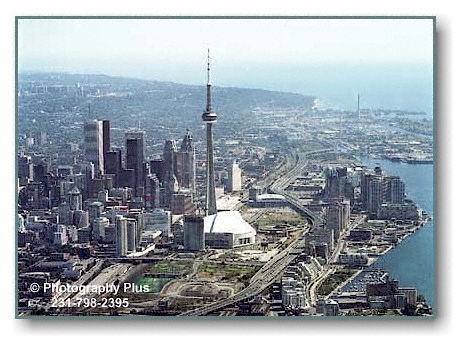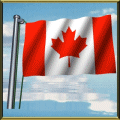Immigration to Canada is the process by which people migrate to Canada and become nationals of the country. As Canada is a relatively new country, a formal immigration process has not been around for very long. Nevertheless, people have been migrating to the geographic region of Canada for thousands of years, patterns varying. After 1947 domestic immigration law went through many major changes, most notably with the Immigration Act, 1976 and the current Immigration and Refugee Protection Act from 2002.
Currently Canada is known as a country with a broad immigration policy which is reflected in Canada's ethnic diversity. According to the 2001 census by Statcan Canada has 34 ethnic groups with at least one hundred thousand members each, and numerous others represented in smaller amounts. 13.4% of the population belonged to visible minorities: most numerous among these are Chinese (3.5% of the population), South Asian (3.1%), Black (2.2%), and Filipino (1.0%).
Canadian citizenship was originally created under the Immigration Act, 1910, to designate those British subjects who were domiciled in Canada. All other British subjects required permission to land. A separate status of "Canadian national" was created under the Canadian Nationals Act, 1921, which was defined as being a Canadian citizen as defined above, their wives, and any children (fathered by such citizens) that had not yet landed in Canada. After the passage of the Statute of Westminster in 1931, the monarchy thus ceased to be an exclusively British institution. Because of this Canadians, and others living in countries that became known as Commonwealth Realms, were known as subjects of the Crown. However in legal documents the term "British subject" continued to be used.
Canada was the second nation in the then British Commonwealth to establish its own nationality law in 1946, with the enactment of the Canadian Citizenship Act 1946. This took effect on 1 January 1947. In order to acquire Canadian citizenship on 1 January 1947 one generally had to be a British subject on that date, an Indian or Eskimo, or had been admitted to Canada as landed immigrants before that date. The phrase British subject refers in general to anyone from the UK, its colonies at the time, or a Commonwealth country. Acquisition and loss of British subject status before 1947 was determined by United Kingdom law (see History of British nationality law).
On 15 February 1977, Canada removed restrictions on dual citizenship. Many of the provisions to acquire or lose Canadian citizenship that existed under the 1946 legislation were repealed. Canadian citizens are in general no longer subject to involuntary loss of citizenship, barring revocation on the grounds of immigration fraud.
Statistics Canada has tabulated the effect of immigration on population growth in Canada from 1851 to 2001.[1]
The highest per capita immigration rate in the world
In 2001, 250,640 people immigrated to Canada. Based on the Canada 2001 Census total population of 30,007,094 people, immigration represented 0.834% population growth that year. On a compounded basis, that immigration rate represents 8.7% population growth over 10 years, or 23.1% over 25 years (or 6.9 million people). This excludes the future children of those immigrants born in Canada, who, while also contributing to population growth, would not be immigrants. Since the 2001, immigration has ranged between 221,352 and 262,236 immigrants per annum.[2] According to Canada's Immigration Program (October 2004) Canada has the highest per capita immigration rate in the world.[3] The three main official reasons given for this are:
- A. The social component – Canada facilitates family reunification.
- B. The humanitarian component – Relating to refugees.
- C. The economic component – Attracting immigrants who will contribute economically and fill labour market needs.
The level of immigration peaked in 1993 in the last year of the Progressive Conservative government and was maintained by Liberal Party of Canada. Ambitious targets of an annual 1% per capita immigration rate were hampered by financial constraints. The Liberals committed to raising actual immigration levels further in 2005. Other political parties have been cautious about criticising of the high level of immigration, because, as noted by the Globe and Mail, "in the early 1990s, the old Reform Party was branded 'racist' for suggesting that immigration levels be lowered from 250,000 to 150,000."[4]
Immigrant population growth is disproportionally concentrated in or near large cities (particularly Vancouver, Toronto, and Montreal). These cities are experiencing the strains that accompany strong population growth causing some residents to express concern about the declining livability of those cities. For example, a Toronto Star article published on 14 July 2006 authored by Daniel Stoffman noted that 43% of immigrants move to the Greater Toronto Area and said "unless Canada cuts immigrant numbers, our major cities will not be able to maintain their social and physical infrastructures".[5] Most of the provinces that do not have one of those destination cities have implemented strategies to try to boost their share of immigration.
According to Citizenship and Immigration Canada, under the Canada-Quebec Accord, Quebec has sole responsibility for selecting most immigrants destined to the province. Quebec has been admitting about the same number of immigrants as the number choosing to immigrate to British Columbia even though its population is almost twice as large.[6]
Immigration categories
There are three main immigration categories:
- Economic immigrants - Citizenship and Immigration Canada uses several sub-categories of economic immigrants. The high-profile Skilled worker principal applicants group comprised 19.8% of all immigration in 2005.[2] In 2001 (the date of the last immigrant employment study) Skilled worker principal applicant landed immigrants had a 34% unemployment rate.[7] Spouses and children of Skilled workers comprised an even larger percentage of the Economic immigrant category at 29.3% of all immigration.[2]
- Family class - Under a government program, both citizens and permanent residents can sponsor family members to immigrate to Canada. While this program has proven to be popular with recent immigrants, it has also been criticized by some for being too open-ended (i.e., a never-ending cycle of people related to yet more people which ultimately extends well beyond the original sponsor), a non-citizen can be a sponsor, and it allows retirees to immigrate who have not contributed significantly to the funding of the Canadian infrastructure, medical or social services system (the free rider problem). This category of immigrants also has a much lower labour force participation rate than economic immigrants.[7]
- Refugees - Immigration of refugees and those in need of protection. This immigrant population has a high unemployment record (51% in 2001) of an already small labour participation rate (44%), resulting in extended financial dependence on government assistance for the vast majority of refugees.[7]
Under Canadian nationality law an immigrant can apply for citizenship after living in Canada for three years.[8]
Economic impact
- See main article, Economic impact of immigration to Canada
Population growth through immigration tends to boost GDP, but not necessarily per capita income depending on whether immigrants have an income above or below the national average, and whether the skills they bring have impacts that multiply benefits throughout the economy. Analysis of census data as of 2000 shows that immigrant incomes were at 80% of the national average after 10 years of residing in Canada.[9]
Some observers note that almost all Canadians are either immigrants or descendants of immigrants and that the Canadian standard of living is one of the highest in the world. Therefore, based on this simple logic, these observers argue that immigration must have been beneficial to the Canadian economy, at least at some point in the past. In 1991, the Economic Council of Canada concluded that "A historical perspective gives little or no support to the view that immigration is needed for economic prosperity. In the 19th and and early 20th centuries, the fastest growth in per capita real incomes occurred at times with net immigration was nil or negative. Later in the 20th century, the opposite linkage is seen but, clearly, there is no long-term correlation." [10] A University of Montreal study published in 2002 by professor Marc Termote used different methods and studied different countries and concluded that immigration has no statistical impact to the per capita income of a country.[11]
The economic impact of immigration differs by immigration category. For example, according to Statistics Canada, there are significant differences in the labour force participation rates. 2001 labour force participation rates by category:[7]
- Economic immigrants: 91%
- Economic immigrant spouses: 63%
- Family class immigrants: 59%
- Refugees: 44%
- Average of all immigrants: 70%
In 2001, the overall unemployment rate of immigrants was 37%. Combined with the overall participation rate of 70%, this means that only 44% of all immigrants (15 years of age and older) were working in 2001. Federal and provincial government social programs can experience greater expense without corresponding tax revenue due to the low employment rate of immigrants. The Fraser Institute claims that the immigrants who arrived between 1990 and 2002 cost governments $18.3 billion (net of taxes raised from those immigrants) relating to universal social services.[12]
Illegal immigration in Canada
Some estimates suggest that there may be up to 500,000 illegal immigrants in Canada.[13] A further unsubstantiated claim is that most are refugee claimants whose refugee applications were rejected by the Immigration and Refugee Board of Canada.[14] If already in the country, Canada does not ask any type of immigration applicant to re-enter the country for any extension or approval of their status. This differs from the U.S. which insists on re-entry for most types of applications, and denies entry if an application is declined.
It stands to reason that there may be very few illegal immigrants who enter the country without first being admitted by the Canada Border Services Agency. The reason for believing this is that Canada is physically very difficult to get to, with the exception of crossing the Canada-United States border. And in this case, since the U.S. is itself a prime destination for illegal immigrants, not many illegal immigrants then attempt an unauthorized border crossing into Canada.
The reality is that there is no credible information available on illegal immigration in Canada.
Immigration and crime
In 2005, Gwyn Morgan raised the issue of linking refugees with crime in Canada, saying among other things that "It's fair to say that most immigrants who abuse our society have come in as refugee claimants rather than 'economic immigrants'." His opinions on this topic were rejected by, most notably, some New Democratic Party and Liberal Members of Parliament.[15]
The federal Public Safety and Emergency Preparedness Canada department ran a successful program from 1999 to 2003 called Project Early Intervention that targeted children in a community "made up of recent Arabic and Somalian immigrants" with the goal of reducing crime.[16] In 2004, Canada established a national action plan, aimed in part at reducing violence, called A Canada Fit for Children which said "children of recent immigrants and refugee children are more likely to experience economic disadvantage with its associated risks."[17]
Terrorist attacks in Canada have been committed by both foreign-born (mostly naturalized citizens) and Canadian-born people. The key suspects (Reyat, Malik, Bagri) in Canada's most deadly terrorist attack, Air India Flight 182, are all foreign-born. Half of the 12 identified alleged terrorists in the 2006 Toronto terrorism case are foreign-born and the other half are Canadian-born. Ahmed Ressam, an illegal immigrant (whose refugee application was previously rejected) living in Canada was an al-Qaeda operative who tried in 1999 to enter the United States to attack it with explosives found in his vehicle, has been referred to by some pundits in the United States as an example of how Canada's immigration policies and allegedly weak controls pose a potential terrorism threat to the United States. Canadian immigrants from Sri Lanka were arrested in the U.S. in August 2006 as part of a terrorist arms-trading plot and have contributed to the impression that Canada's policies facilitate terrorist activity.[18] Nowithstanding incorrect statements from some elected U.S. politicians, none of the terrorists who participated in the September 11, 2001 attacks entered the United States from Canada[19]
The reality is that no credible organization, such as Statistics Canada, has published a study on immigration and crime in Canada, so there are few conclusions on the topic.
thank you wikipedia
 immigrants from the south there has been scant notice of a far more insidious infiltration from our porous border in the north. No one knows how many illegal immigrants from Canada currently reside in the United States. And it is extremely difficult to find out since Canadians, unlike Mexicans, look and speak just like normal Americans. The fact that they are able to blend in so easily makes them, in my mind, even more threatening to our way of life than immigrants from other countries. Some of you might not even realize that Canada is an entirely separate country. Some of your neighbors and co-workers may be Canadian and you might have no idea. Aside from overuse of the word "eh?" and excessive drinking of Molson, many Canadians (at least the English-speaking ones) seem just like us on the outside. Many people don't realize that Canadians have already infiltrated places of power in our country. Ultra-liberal anchorman Peter Jennings was Canadian. Saturday Night Live producer Lorne Michaels is Canadian. The director of the biggest-grossing movie of all time, Titanic, James Cameron, is Canadian. Jeopardy host Alex Trebek is Canadian. Most shocking of all, Pamela Anderson is also Canadian.
immigrants from the south there has been scant notice of a far more insidious infiltration from our porous border in the north. No one knows how many illegal immigrants from Canada currently reside in the United States. And it is extremely difficult to find out since Canadians, unlike Mexicans, look and speak just like normal Americans. The fact that they are able to blend in so easily makes them, in my mind, even more threatening to our way of life than immigrants from other countries. Some of you might not even realize that Canada is an entirely separate country. Some of your neighbors and co-workers may be Canadian and you might have no idea. Aside from overuse of the word "eh?" and excessive drinking of Molson, many Canadians (at least the English-speaking ones) seem just like us on the outside. Many people don't realize that Canadians have already infiltrated places of power in our country. Ultra-liberal anchorman Peter Jennings was Canadian. Saturday Night Live producer Lorne Michaels is Canadian. The director of the biggest-grossing movie of all time, Titanic, James Cameron, is Canadian. Jeopardy host Alex Trebek is Canadian. Most shocking of all, Pamela Anderson is also Canadian.










